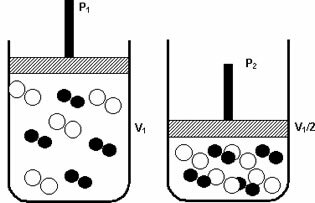O calculating the number of particles in a solution is a fundamental aspect for us to measure the colligative effect (osmoscopy, cryoscopy, ebullioscopy and tonoscopy) caused by the addition of a solute to a certain solvent.
The larger the amount of particles in the solute present in the solution, the more intense the colligative effect. The calculation of the number of particles mainly takes into account the nature of the solute that was added.
The classification of a solute in relation to its nature is carried out as follows:
molecular solute
It is the solute incapable of suffering the phenomena of dissociation or ionization, regardless of the solvent to which it was added. Examples: glucose, sucrose, ethylene glycol etc.
Thus, as a molecular solute does not ionize or dissociate, if we add 15 molecules (particles) of it to the solvent, we will have 15 dissolved molecules.
ionic solute
It is the solute that, when added to the solvent, undergoes the phenomenon of ionization (production of cations and anions) or dissociation (release of cations and anions). Examples: acids, bases, salts, etc.
So if we add 15 molecules of it to the solvent, we have 15 particles plus x particles.
Van't Hoff Correction Factor
Scientist Van't Hoff developed a formula to calculate the correction factor for number of particles of an ionic solute in a solution.
i = 1 + α.(q-1)
Being:
i = Van't Hoff correction factor.
α = degree of dissociation or ionization of the solute;
q = number of particles obtained from dissociation or ionization of a solute;
The Van't Hoff correction factor must be used to multiply the value found for the number of particles in the solution. So, if, for example, the correction factor is 1.5 and the number of particles of the solute in the solution is 8.5.1022, we will have:
number of real particles of solute in solution = 1.5. 8,5.1022
number of real particles of solute in solution = 12.75.1022
or
number of real particles of solute in solution = 1,275.1023
Examples of calculating the number of particles in a solution
Example 1: Calculation of the number of particles present in a solution containing 45 grams of sucrose (C6H12O6) dissolved in 500 mL of water.
Exercise data:
Solute mass = 45 grams;
Solvent volume = 500 ml.
Do the following:
1O Step: determine the molar mass of the solute.
To determine the mass of the solute, just multiply the atomic mass of the element by the number of atoms in it in the formula. Then add up all the results.
Carbon = 12.12 = 144 g/mol
Hydrogen = 1.22 = 22 g/mol
Oxygen = 16.11 = 196 g/mol
Molar mass =144 + 22 + 196
Molar mass = 342 g/mol
2O Step: Calculate the number of particles using a rule of three involving the number of particles and the mass.
Do not stop now... There's more after the advertising ;)
To assemble the rule of three, we must remember that, in a molar mass, the mass is always related to Avogadro's constant, which is 6.02.1023 entities (molecules or atoms, for example). Thus, as sucrose has molecules, as it is molecular (formed by a covalent bond), we have to:
342 grams of sucrose6.02.1023 molecules
45 grams of sucrose x
342.x = 45. 6,02.1023
x = 270,9.1023
342
x = 0.79.1023 molecules
or
x = 7.9.1022 molecules
Example 2: Calculate the number of particles present in a solution that contains 90 grams of potassium carbonate (K2CO3) dissolved in 800 ml of water. Knowing that the degree of dissociation of this salt is 60%.
Exercise data:
Solute mass = 90 grams;
Solvent volume = 800 ml;
α = 60% or 0.6.
For determine the number of solute particles in that solution, it is interesting that the following steps are developed:
1O Step: determine the molar mass of the solute.
To determine the mass of the solute, just multiply the atomic mass of the element by the number of atoms in it in the formula. Then add up all the results.
Potassium = 39.2 = 78 g/mol
Carbon = 12.1 = 12 g/mol
Oxygen = 16.3 = 48 g/mol
Molar mass =144 + 22 + 196
Molar mass = 138 g/mol
2O Step: calculate the number of particles using a rule of three involving the number of particles and mass.
To assemble the rule of three, we must remember that, in a molar mass, the mass is always related to Avogadro's constant, which is 6.02.1023 entities (ion-formula, molecules or atoms, for example). Thus, as the carbonate has an ion-formula because it is ionic (formed by an ionic bond), we have to:
138 grams of carbonate 6.02.1023 molecules
90 grams of carbonate x
138.x = 90. 6,02.1023
x = 541,8.1023
138
x = 6.02.1023 formula ions (particles)
3O Step: calculate the number of particles (q) from the dissociation of the salt.
In potassium carbonate, we have the presence of two potassium atoms in the formula (K2) and a unit of the anion CO3. So the value of q for this salt is 3.
q = 3
4O Step: calculate from the Van't Hoff correction factor.
i = 1 + α.(q-1)
i = 1 + 0.6.(3-1)
i = 1 + 0.6.(2)
i = 1 + 1.2
i = 2.2
5O Step:determine the number of real particles present in the solution.
To determine the number of real particles in this solution, simply multiply the number of particles calculated in 2O step by correction factor calculated in 4O step:
y = 6.02.1023. 2,2
y = 13,244.1023 particles
By Me. Diogo Lopes Dias

